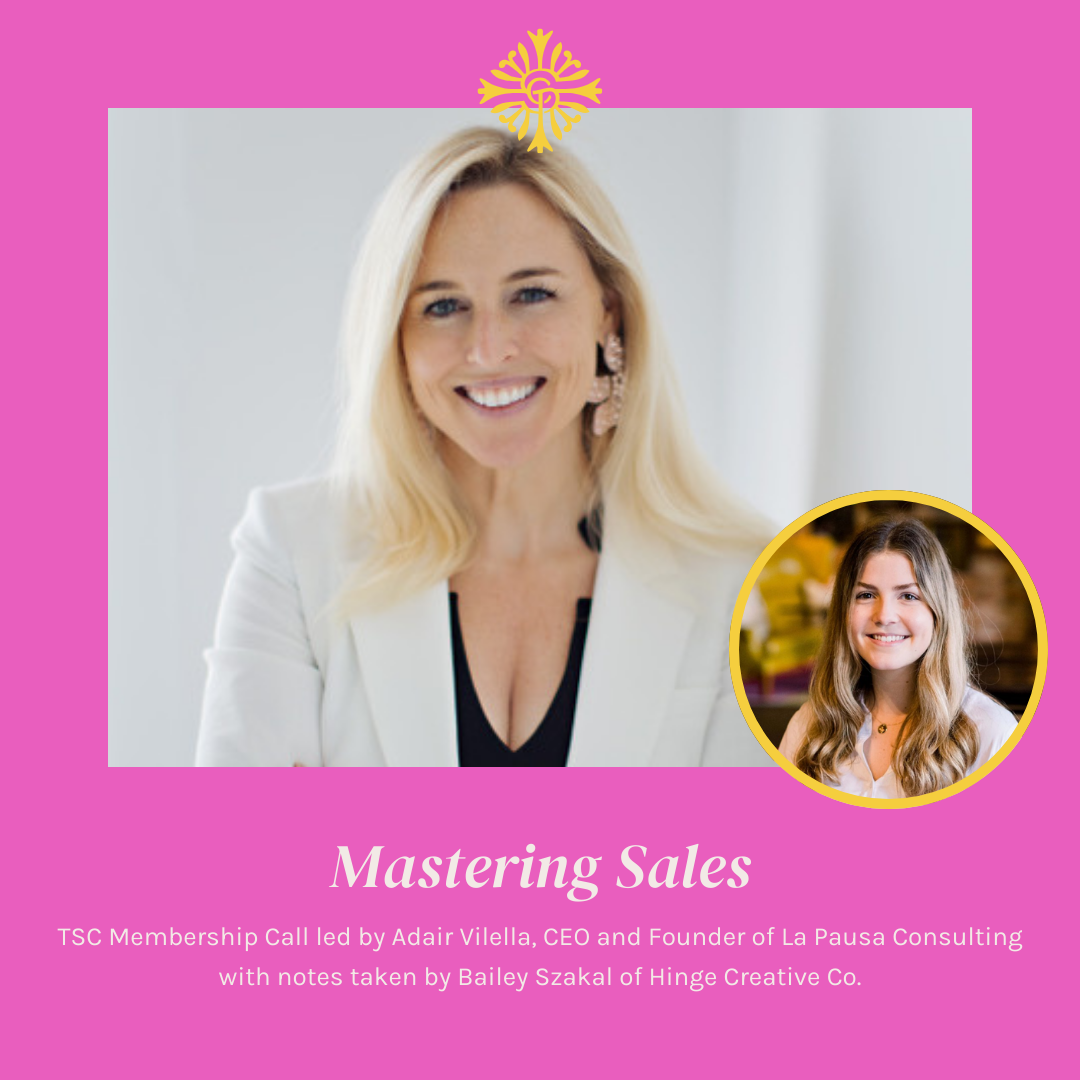Membership Call Recap: Mastering Sales
Apr 18 2024
by Katelyn Whelan

Mastering Sales
Presenter: Adair Vilella, CEO and Founder of La Pausa Consulting
Notetaker: Bailey Szakal of Hinge Creative Co.
Adair Vilella helps us understand sales, how it differs from PR and Marketing, and which type of sales representative is right for your business.
Sales is a separate department than marketing.
Marketing Corporate Organizational Chart:
CEO
→ CMO (Chief Marketing Officer)
→ VP of Marketing
→ Director of Marketing
→ Brand Manager
→ Social Media Manager
→ Email/SMS Manager
→ e-Commerce Manager
Sales Corporate Organizational Chart:
CEO
→ CRO (Chief Revenue Officer)
→ VP of Sales
→ Director of Sales
→ Business Development
→ Account Executive
The Differences Between PR, Marketing, and Sales
While PR builds the reputation, marketing builds the desire, and sales fulfill that desire.
Public Relations:
- Objective – Build and manage reputation, creating a positive public image.
- Focus – Media relations, crisis management, and communication with stakeholders.
- Tools/Methods – Press releases, public events, social media
- Impact & Measurement – Media coverage, public sentiment, relationship strength.
Marketing:
- Objective – Promote and position products or services to target audiences
- Focus – Market research, branding, and advertising strategies
- Tools/Methods – Advertising, content management, SEO, social media campaigns
- Impact & Measurement – Lead generation, customer engagement, return on investment (ROI)
Sales:
- Objective – Directly facilitate the exchange of products or services for monetary compensation
- Focus – One-on-one interactions, understanding customer needs, closing deals
- Tools/Methods – Prompt demos, negotiations, sales presentations
- Impact & Measurement – Sales volume, revenue, customer acquisition costs
Marketing drives sales, Business Development drives sales, but Sales truly drives sales. Let’s break down the differences between the three and their roles in your business.
Marketing:
- Branding, Marketing Collateral, Jobsite Signage, Vehicle Graphics
- Website, e-commerce
- Content Marketing (blogs, videos, e-newsletters)
- Sponsorships
- Social Media
- Articles in Publications (corporate communications)
- Public Relations
- Proposal submittals consistent with branding
Business Development Rep:
- Networking
- Referrals
- Client Relationship building
- Face-to-face client prospecting (one-to-one meetings)
- Trade Shows
- Conference presentations
- Client Association Memberships
- Community and civic involvement
Sales Rep:
- Closes deals
- Interviews from won proposals
- Contract review and negotiations
- Maintains client relationships
- Up-sells and/or cross-sells to existing clients
- Partners with Marketing to create campaigns to generate sales (existing or new clients)
Many times people are investing in PR and Marketing, but they don’t have the foundation to collect data and follow up with exposure to convert into sales. That’s why each element is crucial to your success.
There are two types of sales and they differ in targets, cycles, and relationships:
B2B: Business to Business (i.e. Wholesale)
- Sales Target: The target is other businesses. Sales are made to decision-makers, within the company, such as purchasing managers or executives.
- Sales Cycle: Tends to have a longer sales cycle. It often involves multiple stages of approvals and a higher level of deliberation and negotiation.
- Relationships: Relationships are key in B2B sales. Building strong, long-term relationships with clients is crucial because of the potential for long,recurring transactions.
B2C: Business to Consumer (i.e. Retail Sales Associate)
- Sales Target: The target is individual consumers purchasing for personal use.
- Sales Cycle: Usually has a shorter and simpler sales process. Buyers decide fast, often on a whim or based on feelings.
- Relationships: Individual sales depend less on personal relationships, but brand loyalty can help.
Marketing Differences in B2B and B2C Sales:
- B2B: Marketing strategies focus on logical process-driven purchasing decisions through content marketing, industry events, and direct outreach
- B2C: Emphasizes mass market communication through advertising and promotional strategies aiming to reach a ;large audience and evoke an emotional response.
These differences highlight why strategies in sales and marketing need to be tailored according to whether the focus is on businesses or direct to consumers. Each approach requires distinct strategies, channels, and communication staples to effectively reach and engage the respective audiences. Main takeaway: SEGMENT your audiences!
Inbound Sales vs. Outbound Sales:
Inbound sales align with customer-driven trends, while outbound sales pushes towards broad market engagement.
Inbound Sales (Sales coming to you): Focus on attracting customers through content and interactions that are relevant and helpful. These sales methods are customer-initiated, often resulting from the customer’s own research and engagement with the company’s content like websites, blogs, or social media.
Outbound Sales (Digging for extra revenue): Involve proactive outreach to potential customers. Sales representatives initiate contact through cold calling, emails, or direct email to pitch products or services to potential customers who may not have expressed prior interest. Takeaway: Don’t rely on what marketing is bringing you to hit your sales goals.
Alignment on Sales & Marketing:
Marketing brings the exposure, Sales turns it into recurring revenue.
Top of Funnel (Marketing Team): Brings visitors and leads to your business through digital marketing.
Middle of Funnel (Sales Development): Goes through and qualifies marketing leads, then passes them off to the sales team.
Bottom of Funnel (Sales Team): Explores opportunities by conducting discovery calls and closing the client to gain their business.
**Sales development teams are more common in large enterprises. Small businesses may hire someone part-time to handle this portion of the funnel.
What type of Sales Rep is right for your business?
- Wholesale: B2B
- Account Executive: B2B
- Business Development Rep: Hunter and Gatherer
- They find the types of businesses /people you want to work with, set up the meeting, and bring them to you. If hiring a sales rep to complete the full sale cycle, this typically requires a commission structure.
- Sales Associate: B2C Sales
Sales Reps Needs
- How to tell the brand story
- E-Learning Sales Training Videos
- Have a CEO record a discovery call pitching a client so the sales reps can see how they share the brand story and repeat it on their own calls.
- Look Books, Pitch Decks, Brand Story Videos
- Repeatable Sales approach that can be replicated to all new hires
- A CRM – Collect and Track Data
- Serve as a source of one truth for the account; not a huge expense but invaluable
- Whole team can follow along on meeting notes, pitch decks, proposals, contracts, etc.
- All saved in one place- will make your life easier with new hires and turn over
- Holding your Sales rep accountable on weekly activity and outreach
- Once Closed: Account management, to upsell and cross-sell
- Align Marketing and Sales
Typical Sales Journey: The Road to $
- Outreach, Networking, Follow Up
- Networking
- Gathering leads
- Following Up
- Booking Meetings
- Call 1: Discovery Call
- Proposal Presentation
- Call 2: Proposal Review
- Closing the Deal
Key Takeaway: Let them talk about their pain points before selling/ talking numbers. Don’t let them get off the first call before you have another meeting set to review your proposal and close the deal.
Encouragement To Business Owners:
- When hiring a sales rep, bring in that natural candidate that can run out network, attend groups and seminars and gather names and leads for your business.
- If you as the business owner hate these types of modalities, then pass it off to someone who thrives in it
- Don’t let this stress you out! Instead, let someone represent you!
Something to Think On: Ask yourself, “Where am I relying too much on marketing and not enough on sales?”
Did you enjoy this blog post?
Join TSC Membership and learn from industry experts every Tuesday at 11 am est on a live zoom call. Already a member? Be sure to check out the Private Content Library to catch up on missed calls or rewatch a favorite!
0 COMMENTS
Katelyn Whelan View More Blog Posts from this Author
Katelyn is a graduate of the University of Notre Dame, where she earned a dual degree in Marketing & Visual Communication Design. Settling in her hometown of Savannah, GA, she has spent the past 5 years building a career working with female owned small businesses. From events to retail, she has learned the art of translating ideas into action. Specializing in digital marketing, she seeks to bring the passion of her clients to life through the power of social media & e-commerce. She is the digital arm of a design firm founded with her two sisters, The Whelan Girls.
When she is not working, you can find her at the beach. She loves spending time with her family and can whip up a killer batch of chocolate chip cookies.




Leave a Comment